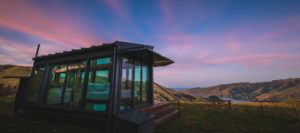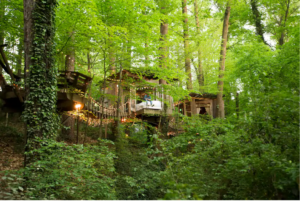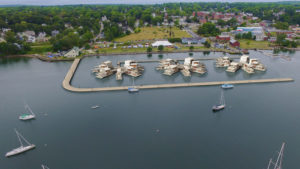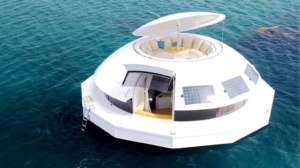Getting off the beaten path
Whether it’s newcomers looking for comfortable entry into the outdoor adventure world, or seasoned outdoors people looking to get away from the crowds, a new form of adventure travel and hospitality has emerged to support the burgeoning demand.
One of the hottest new trends is glamping. Defined loosely as glamorous camping, glamping combines camping with many of the luxuries and amenities of a premium resort. This can include gourmet meals, king-size beds, egyptian cotton sheets, and unlimited hot water for showers in the morning.

Pōhue PurePod is just an hours drive from Christchurch, New Zealand
This once obscure segment is expected to reach $5.41 billion by 2028. The boom of the travel category has captured the eyes, imaginations, and pocketbooks of players big and small creating a bonanza of creativity. Designers and developers across the world are reimagening hospitality in remote outdoor locations ranging from high-alpine mountain tops to remote islands and lagoons.
Outdoorsy, a company that bills itself as the AirBNB of RVS is expected to hit $1 billion in sales by the end of next quarter. Popular glamping operators like Under Canvas have received multi-million dollar investments from major private equity firms, suggesting that the trend is real and mainstream.
French designed Anthenea is a UFO-like, 360-degree, floating pod able to accommodate 2-4 adults overnight. On land, tree houses such as the one featured below in Georgia have found notoriety earning top slots as the most booked listing on AirBNB, some booked completely solid until 2023. In New Zealand, guests are willing to hike-in miles to stay in tiny home lodges, which feature unobstructed views and a DIY philosophy.
The attraction and appetite for these types of adventures is multiplied by a new wave of social-media driven travelers, eager to measure their experience in the number of Instagram likes and interactions they receive.
Where does it all go from here?
Like much of the brave new post-pandemic world, the landscape for outdoor adventure travel will continue to change and evolve at breakneck speed. Some of the trends and ideas along the way may be reviewed in the rearview mirror as chintzy, flash-in-the-pan concoctions of opportunistic developers. Already, pockets of concerns are emerging in areas where developers have been accused of cutting corners by bypassing zoning requirements, building codes, and fire mitigation standards.

Secluded Intown Treehouse in Georgia booked solid until 2023
But beyond the inevitable bumps along the way of a new segment, it is very likely that glamping and thirst for limit-pushing adventure travel is here to stay. For the scrupulous and thoughtful designers and developers, the opportunities to find solutions that connect more people to nature while balancing safety and environmental stewardship are massive. The question that remains, who will do it best.

